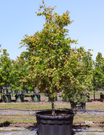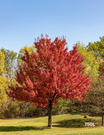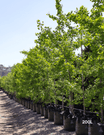Acer palmatum, commonly known as the Japanese Maple, is a timeless favorite for gardens of all sizes. This elegant deciduous tree has been a cherished part of Japanese culture for centuries, symbolizing peace, balance, and beauty. With its delicate foliage, stunning seasonal color changes, and artistic branching, the Japanese Maple stands out as a tree that offers year-round interest. This tree is more than just a plant for high-end gardens—it expresses luxury, style, and craftsmanship in landscape design.
The Aesthetic and Cultural Value of Japanese Maples
The appeal of the Japanese Maple goes beyond its stunning appearance. Its deep cultural roots in Japan make it a symbol of patience, balance, and tranquility—qualities that resonate in high-end landscapes worldwide. The Acer palmatum’s ability to transform a garden space into something vibrant and peaceful has made it a popular choice among those who seek to create luxurious, calming environments.
The Japanese Maple can be used as a statement feature or part of a larger, harmonious landscape design in a garden. Its year-round visual interest—vibrant in spring, stunning in autumn, and structurally fascinating in winter—makes it an irreplaceable addition to any garden.
Acer palmatum (Japanese Maple)
Acer palmatum is widely regarded as one of the most beautiful small trees you can add to your garden. With its finely cut leaves that come in shades from deep green to vibrant red and its stunning autumn transformation, this tree provides an unparalleled visual spectacle throughout the year. Its delicate branches and soft, layered leaves create an architectural quality that enhances formal and informal garden designs.
As a relatively slow-growing tree, the Japanese maple allows gardeners to enjoy a long-lasting landscape feature that remains manageable. Its compact size and stunning color palette make it perfect for smaller gardens or as a focal point in a large estate. Whether you plant it in a shaded courtyard or place it in full view as a feature tree, the Japanese Maple offers a timeless elegance that complements any garden design.
Key Facts
- Mature Height: 4–6 meters
- Mature Width: 3–4 meters
- Best Uses: Feature tree, courtyard tree, accent planting, focal point in garden beds
- Leaf Appearance: The leaves are delicate and multi-lobed, with a range of colors from green to deep burgundy; autumn colors are especially vibrant in hues of orange, red, and gold.
- Rate of Growth: Slow to moderate
- Tolerates: Partial shade, moist, well-drained soils, and slightly acidic conditions

Why It’s Perfect for Your Garden
The Japanese Maple is an ideal choice for those who value subtle luxury. Its seasonal transformations—from the fresh, soft greens of spring to the blazing reds of autumn—create an ever-changing visual experience that elevates any garden. The Japanese maple brings quiet sophistication and understated elegance when used as a centerpiece or companion to other plantings. It’s not a demanding tree, yet it offers an extraordinary return on investment in terms of beauty and cultural significance.
How Japanese Maples Elevate Your Garden
A Seasonal Showpiece
One of the Japanese Maple's most attractive features is its changing colors. As summer turns to autumn, Acer palmatum comes alive with fiery reds, oranges, and yellows that captivate attention. Even in winter, the tree’s delicate, fine branches add architectural interest, standing against bare landscapes. In spring, the fresh new growth revitalizes the garden, making it feel alive and vibrant again. Each season tells a different story with a Japanese Maple, making it an evergreen favorite in aesthetic interest.
Architectural Qualities
A Japanese Maple’s structure is as captivating as its foliage. The multi-lobed leaves, borne on gracefully arching branches, create a soft, layered canopy that offers dappled shade below. Its architectural form is ideal for adding depth and dimension to a garden. The Japanese Maple fits perfectly whether you want a statement tree in your entryway or a quiet, contemplative feature in a Zen-style garden.
Low Maintenance, High Impact
For all its beauty, the Acer palmatum is remarkably low maintenance. It thrives in well-drained soils and requires little pruning beyond shaping for aesthetics. Once established, it’s relatively drought-tolerant, making it an excellent option for busy homeowners who want beauty without excessive upkeep. High-end clients will appreciate that the Japanese Maple delivers elegance without requiring constant attention.
Planting and Care Tips for Japanese Maples
- Choose the Right Spot: Japanese Maples prefer partial shade and thrive in sheltered areas protected from strong winds.
- Soil Preparation: Plant in well-drained, slightly acidic soil to encourage vibrant foliage and healthy root development.
- Watering: Keep the soil moist, especially during dry periods, but avoid waterlogging the roots.
- Mulching: Apply a layer of organic mulch around the tree's base to conserve moisture and protect the roots.
- Pruning: Light pruning in late winter or early spring helps maintain the desired shape and promotes healthy growth.
Frequently Asked Questions (FAQs)
-
Can Japanese Maples grow in containers?
Yes, Japanese Maples, especially dwarf varieties, do well in containers. This makes them ideal for patios, courtyards, and balconies, offering flexibility in design. -
Do Japanese Maples need a lot of sunlight?
Japanese Maples prefer partial shade, especially in hotter climates. Too much direct sunlight can scorch the delicate leaves, so it’s best to plant them in a location with filtered light or afternoon shade. -
How fast do Japanese Maples grow?
Japanese Maples are slow to moderate growers. Depending on the variety and growing conditions, they gain about 30cm to 60cm per year on average. -
What kind of soil do Japanese Maples prefer?
They thrive in well-drained, slightly acidic soil. To improve drainage, amend heavy clay soils with organic material, as standing water can harm the roots.
Conclusion
A garden featuring an Acer palmatum isn’t just a garden—it’s a carefully curated experience. Japanese Maples bring together beauty, culture, and functionality in a way few other trees can. Their ability to elevate a space with minimal effort makes them a brilliant choice for high-end clients seeking sophistication and timeless appeal. Whether as a centerpiece or a complementary planting, the Japanese Maple will create a vibrant, ever-changing focal point that offers your garden serenity, beauty, and subtle luxury.















































Leave a comment
This site is protected by hCaptcha and the hCaptcha Privacy Policy and Terms of Service apply.